Top News

May 22, 2014 Ryukyu Shimpo
There have been two recent incidents involving parts of aircraft breaking off and falling away. The aircraft were an HH-60G Pave Hawk helicopter and an F-15 Eagle. The Kadena Town Assembly has since unanimously passed a written statement and resolution to protest against these accidents in a special session held on May 22. In the resolution, they filed four requests, including prohibition of flight training of the U.S. military aircraft over residential areas.
The assembly members handed over the documents to the Okinawa Defense Bureau on the same day.
A representative of the assembly said, “We have been protesting and asking the U.S. military to inspect the aircraft for safety management every time accidents occur. However, we feel angry that they have not improved the issue.”
The assembly asked the U.S. military to take preventive steps to avoid such accidents, find out the causes and swiftly announce them. They also asked for prohibition of flight training over residential areas.
Assembly member Tsuneaki Okuma, who proposed the resolution, talked about continuing accidents involving F-15 fighters. He said, “Even though the U.S. military claimed that they made doubly sure on the safety of the aircraft, we cannot trust what they say any more. They need to remove the flawed aircraft as soon as possible.”
(English translation by T&CT)
Go to Japanese

May 21 2014 Ryukyu Shimpo
The Okinawa Prefectural Government (OPG) announced a plan to attract more tourists to Okinawa in the 2014 fiscal year on May 20. The government has aimed to attract 6.9 million tourists to Okinawa. The number has increased by 4.9 percent from the number of tourists in the 2013 fiscal year (6.58 million). It has also increased by 100,000 from the number aimed for in a previous plan announced in March.
Of the tourists coming to Okinawa, the OPG aims to attract 800,000 foreign tourists, which is a 27 percent increase on the previous year (630,000). The government plans to gain 497 billion yen in tourism revenue, which is an 11.4 percent increase from the estimates.
Seijun Wakugawa of the OPG said, “There is a concern that low-cost carriers lack the number of pilots. However, we expect that the number of tourists visiting Okinawa to increase due to a buoyant economy and continuing cheap yen.” He went on to say, “We would like to continue to promote Okinawan tourism in and outside Okinawa and improve local hospitality towards tourists.”
For fiscal 2014, the government is aiming for 72,000 yen in average expenses per person. The number has increased by 6.2 percent from the estimates. They aim for 80,000 yen in average expenses per foreign tourist. The government aims for 3.95 days for average length of stay. The number increased by 0.18 days from the estimates. They aim for 5.5 days for average length of stay for foreign tourists. The government aims for 20.04 million tourists staying in Okinawa. The number increased by 9.8 percent from the estimates.
The government expects the number of seats provided by aircraft flying domestic air routes will increase by 300,000, and 200,000 flying international air routes, compared with the previous year. Based on that, the government expects that the number of tourists coming to Okinawa from mainland Japan will increase by 140,000 with a 120,000 increase in foreign tourists.
The OPG expects that cruise ships will call at ports in Okinawa 101 times, which is a 21 increase from the estimates. That will contribute another 30,000 to the increase in tourists visiting Okinawa.
(English translation by T&CT)
Go to Japanese
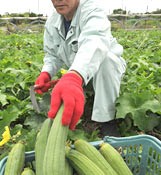
May 16, 2014 Ryukyu Shimpo
The Loofa or Hechima harvest has started in Okinawa. The harvest season is from the end of May to July. Mainland Japanese do not have the custom of eating loofa, but it is a popular vegetable during summer in Okinawa.
Hiroshi Tome, a fifty-two-year-old, second-generation farmer who lives in Tomigushiku, grows loofa. “Dark green and growing straight, loofas taste excellent,” he said. “Boiled loofa gives a savory taste so it is delicious just with canned tuna and salt. I want people to try the dish if they have never eaten it before.”
(English translation by T&CT, Hitomi Shinzato)
Go to Japanese
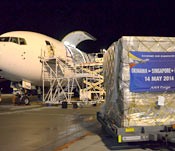
May 15, 2014 Ryukyu Shimpo
All Nippon Airways (ANA) has started new cargo flights between Okinawa and Singapore as part of its international cargo project. The cargo flight on this route left for Singapore at 5:00 a.m. on April 14.
There will be six flights per week from Okinawa, with a flight time of about five hours. Singapore is centrally located in Asia and is close to countries with many industries. ANA plans to use Singapore as a new base to expand its industrial goods and foodstuffs import and export business.
With the Singapore route available, Yamato Transport will launch its Cool Takkyubin courier service to Singapore before the end of 2014.
The opening of the Singapore-Naha route brings the number of ANA freight services operating from Okinawa to eight outside Japan and four within the country. The first flight on this route carried about 41 tons of cargo, mainly electronic items and pharmaceuticals. ANA aims to keep at least 70 percent, which is the ratio of the actual cargo load by weight to the available cargo weight capacity, for future flights.
Yamato Transport, which began its Cool Takkyubin service to Hong Kong in 2013, plans to start services in Taiwan in the first half of 2014.
The head of the Okinawa branch of ANA Cargo Inc. Masaki Tanimura said, “We would like not only to use Okinawa as a hub, but also to promote local industries actively to leverage advantages for the prefecture.” An official of the prefectural government said, “Singapore is a country with high buying power. We hope to export fresh foods to the country as well. The opening of the Singapore route will be a boost for the Okinawa Trade Fair in November.”
(English translation by T&CT and Lima Tokumori)
Go to Japanese
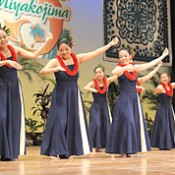
May 20, 2014 Ryukyu Shimpo
International Hula Dance competition Kagimana hula Miyakojima 2014 was held at Mateada Civic Theater and other venues in Miyako City from May 16 to 18.
The contenders performed gracefully, dancing to Hawaiian music and captivating the audience.
About 160 people from 23 Japanese groups took part in the competition held on May 18. They competed in four divisions: Wahine (Women from the age of 14-44 years old), Kupuna (Women from the age of 45 years and older), Kane (Men), Keiki (children from ages 3-13 years old).Okinawan Hula dance group Kailua Hula Studio won Wahine. A representative of the group Taiki Nakamoto said, “I think that we could convey our dedication to dancing. We would like to win both Wahine and Kane next year.”

Female spectators gave a big cheer for the dance performed by men at Mateada Civic Theater in Miyakojima City on May 18.
Hau’olis Masako Aketa Hula Studio from Okayama Prefecture won Kupuna and Mahalo Hula Studio of Okinawa won Kane.
The organizers held an exhibition and Hula Picnic, and stencil art class, at special stage in Toriba district of Hirara, Miyakojima City on May 17.
Many citizens took part in the event, enjoying the folk dance style of Hula.
(English translation by T&CT)
Go to Japanese

Children enjoyed Hawaiian stencil class at a Hula Picnic in Hirara, Miyakojima City on May 17.
May 19, 2014 Ryukyu Shimpo
The world’s largest convenience store operator Seven-Eleven, Inc. plans to tap into markets in Okinawa. The company is negotiating with Okinawan companies about affiliating, building stores, and acquiring factories.
Seven-Eleven is targeting Okinawa as a new market because it is one of the few prefectures with rising populations and robust individual consumption. The company is asking the stores franchised by other convenience store operators to be franchised by Seven-Eleven. The number of convenience stores in Okinawa is over 500, which meets current demand. Seven-Eleven has already opened over 100 stores in each prefecture. Its arrival in Okinawa will spur competition between convenience store operators.
A representative from the Okinawa distribution industry said, “Seven-Eleven carried out market research for Okinawa a long time ago. The company predetermined to tap into markets in Okinawa. We expected Seven-Eleven to open stores in March. It’s just a matter of time.”
Seven-Eleven usually concentrates on specific locations to open stores for increasing efficiency of distribution. The company plans to start operating several dozen stores in the near future in Okinawa.
The company plans to build its own factories in Okinawa in order to standardize food products nationwide. According to the representative, Seven Eleven’s partner production companies have been looking for properties in Okinawa for many years.
Several companies in Okinawa have tried to get a stake in store management, however the company says all stores will be operated by mainland-based Seven Eleven.
Currently the convenience store market is shared between Okinawa, Okinawa FamilyMart, which holds 46.2 percent of the total, LAWSON Okinawa, Inc. with 32.8 per cent and Coco Convenience Store with 20.8 percent.
Seven-Eleven’s venture into Okinawa could mean that these companies have more competition. At the end of April, Seven-Eleven has 16,450 stores nationwide.
Among the major convenience store operators in Japan, Seven-Eleven is the only company that has not opened stores in every prefecture. It has not tapped into markets in four prefectures, including Okinawa, Aomori, and Totori, Kochi. The company plans to open stores in Kochi. Toshifumi Suzuki, a chairperson of Seven & I Holdings Co., Ltd. a holding company of Seven-Eleven, said stores would open in Aomori in the near future.
(English translation by T&CT)
Go to Japanese
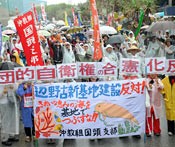
May 19, 2014 Ryukyu Shimpo
On May 18, the last day of the 37th peace march, a rally to protect life and peace was held in Ginowan. The march and rally commemorate the 42nd anniversary of Okinawa’s reversion to Japanese sovereignty from the United Sates occupation. Despite heavy rain, about 2,100 people took part in the rally. The event was cut short and moved to a different location due to the weather.
Participants criticized the Abe administration for its forcible building of a new air base in Henoko, Nago. They also protested against Prime Minister Abe’s attempt to change the government’s long-standing interpretation of the constitution in order to exercise the right to collective self-defense. They pledged that they would spread the movement against the Abe administration from Okinawa to the rest of the country.
On May 16, three peace marches were held in different regions of Okinawa main island, culminating in a rally in Ginowan on May 18. Marches were also held in Yaeyama and Miyako Islands. According to the organizer, about 5,370 people took part in the weekend of marches, which were held on five courses, spanning a total of 136.8 kilo meters, in the main Island of Okinawa, Miyako and Yaeyama Islands. The participants walked near U.S. bases and sites of the Battle of Okinawa.
Hiroji Yamashiro, the director of the Okinawa Peace Movement Center and the chairman of the executive committee of the peace march, called the participants to action. “We have determined ourselves with the participants across the country to reject giving way to the war policy of the Abe administration. We want you from other prefectures to deliver our messages to your people.”
Representatives from each march read this rally declaration to the participants, adding “we will reject the war plot by the government, which is stepping forward on the road to war and we will oppose a constitutional revision. We will struggle for the world peace.” The participants raised the spirit with shouts of “ganbaro!” (Let’s do our best!) three times at the end.
(English translation by T&CT)
Go to Japanese
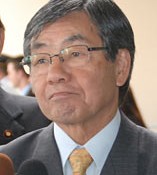
May 21, 2014 Ryota Shimabukuro of Ryukyu Shimpo reports from Washington D.C.
Nago Mayor Susumu Inamine met Peter Hemsch, the deputy director of the Office of Japanese Affairs at the U.S. State Department on May 19. The mayor conveyed his intention to oppose the plan to relocate U.S. Marine Corp Air Station Futenma to Henoko, Nago. But Hemsch said the US would move forward with this plan because both the national governments had already decided. He added that the governments had created a road map and reached the current plan over a long period of consultation.
At his meeting with the deputy director, Inamine stressed, “74 percent of residents are opposed to the Henoko relocation according to polls, even after the Okinawan governor’s approval of the Henoko landfill. I was also re-elected in the mayoral election in January. I do not think the relocation work will proceed smoothly.”
Patrick M. Cronin, a senior advisor at the Center for a New American Security, said he would support the Henoko relocation because of the Okinawan governor’s approval of the landfill. He said it provided important deterrence in the territorial issue between Japan and China. Cronin had questioned the Henoko relocation in papers he published.
After the meeting with the mayor, Cronin told reporters why he had changed his position the Henoko relocation. He said though he would like to respect the opinion of the re-elected mayor, he stressed that the Okinawan governor had made a decision on the plan, and that the US and Japanese governments had already consulted with the people of Okinawa for many years.
Inamine met former Senator Jim Webb, who led the review of the Henoko relocation in the U.S. Senate Armed Services Committee, 2012. The former senator says it is difficult to carry out the Henoko relocation. He said that he could not engage in direct lobbying, because he retired from his job as a senator. However, he said he would like to help the mayor as an individual.
The mayor also delivered a lecture at the Cato Institute, the libertarian think tank, which advocates a conservative viewpoint on a number of issues. Doug Bandow, a senior fellow at the institute and the facilitator of the lecture by the mayor, suggested a solution to the Futenma issue; bring back the Marine Corps to the United States. He said that the United States could not afford to continue to station military overseas for the next 10 or 20 years, due to economic and budgeting problems.
(English translation by T&CT)
Go to Japanese
May 16, 2014 Ryukyu Shimpo
On May 15, Prime Minister Shinzo Abe expressed his willingness to review interpretation of the constitution to exercise the right to collective self-defense. Many residents living near U.S. military bases and survivors of the Battle of Okinawa were alarmed by this, concerned it puts Japan on the road to war. On May 15, 1972, Okinawa was returned from the United States’ military occupation to Japan’s sovereignty and its pacifist constitution. On the same day, 42 years later, Japan`s peace doctrine is now up for debate. Participants from all over the country joined the 5.15 peace march in Okinawa, voicing their view that the constitution and democracy of Japan are being trampled on.
Jumei Kinjo, 85, a survivor of compulsory mass suicide on Tokashiki Island during the Battle of Okinawa, said, “The government is trying to regain the ability to use force abroad. It’s an act of changing the essence of the constitution, which promises no more war,” he said. “The use of force leads us to war. As one of those who have experienced the war, I am absolutely against the use of force.”
Toshie Asato, 93, lost 11 family members, including her husband and two children, in the battlefield on the southern part of the main Island of Okianwa during the war. She said, “Japan is following the path of war again.” In her mind, the government’s recent moves over the constitution are reminiscent of Japanese militarism education during pre-war and war times. She stressed, “We should warn the people that the government will deceive the people, and we should tell the future generations not to repeat the tragedy,” she said. Asato continues to try to protect Article 9 of the constitution through her work as a storyteller of the war experience.
Kiku Nakayama, 85, the chairwoman of the Shiraume Alumni Association of the Okinawa Daini Women’s High School, said, “We can’t agree with an idea of building world peace through military power. Even if the geopolitical situation is severe, it is the politician’s role to get over the difficulties.” During the Battle of Okinawa, Nakayama and other students of the school were assigned by the Imperial Japanese Army to serve as nurse-aides to wounded soldiers.
” Prime Minister Abe is increasingly talking to the Japanese public in a persuasive way. I worry that the young people will comply with his intention,” she said.
“We should let the youth know the truth as much as they are able to understand it.”
(English translation by T&CT)
Go to Japanese
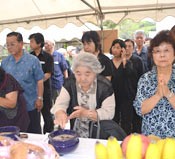
May 16, 2014 Ryukyu Shimpo
On May 15 at the Statue of Davao at the Peace Memorial Park in Itoman City, the Okinawa Davao Association held a memorial service. About 150 people attended, including bereaved families of the victims of the Pacific War who died in Davao in the Philippines. They prayed for the war dead.
Before the Pacific War, many Okinawans emigrated to Davao. Later they became victims of the war. At the service, the president of the Okinawa Davao Association Yoshihiro Yamaniha stated, “It has been 69 years since the end of the war. However, the memory of the war remains deep in my brain and I cannot forget it.”
Seventy-three-year-old Sachiko Ishihara attended the service with her two sisters. She lost her little brother because of malnutrition when she and her family members evacuated to the mountains to avoid US military attack. Not knowing the war had ended, her family stayed hiding in the mountains after August 15. After the war, her family returned on a ship to Sasebo in Nagasaki Prefecture. However, her then-ten-year-old and eight-year-old brothers died from pneumonia.
Sachiko said, “If a war occurs, children who are short on physical strength will be the first victims. We should never cause any wars again.”
The Okinawa Davao Association will visit Davao City from July 20 to 26 to attend a memorial service.
(English translation by T&CT and Megumi Chibana)
Go to Japanese
May 16, 2014 Ryukyu Shimpo
In fiscal 2014, the Okinawa Prefectural Government (OPG) will work on a project to train people who speak foreign languages to become diving guides.
The OPG aims to equip job seekers who can speak foreign languages with the diving expertise and skills needed to safely guide tourists.
Consulting with diving shop owners, the government plans to recruit eight people by August.
With the aim of producing qualified diving instructors, the government will carry out training courses. They hope the project will contribute to human resource development and increase employment in Okinawa. The OPG will recruit candidates through unemployment offices from June.
Participants will get a diving guide license and become nationally licensed marine divers at the end of the training.
The project is costing the government about 300,000 yen.
According to the OPG, the number of foreign divers has been increasing with the rise in the number of foreign tourists visiting Okinawa. However, there are few diving shops that can cater to foreign divers in Okinawa. According to the OPG, the issue needs to be addressed so the prefecture can keep up with tourist demand and host these tourists.
A spokesperson of the government said, “We would like to make sure that foreign divers feel safe and help them enjoy the sea of Okinawa.”
Scuba diving accounted for 6.8 percent of foreign tourist activities in Okinawa in fiscal 2012. The majority of foreign tourists come from Europe, the mainland of China and North America.
(English translation by T&CT)
Go to Japanese










 Webcam(Kokusai Street)
Webcam(Kokusai Street)


